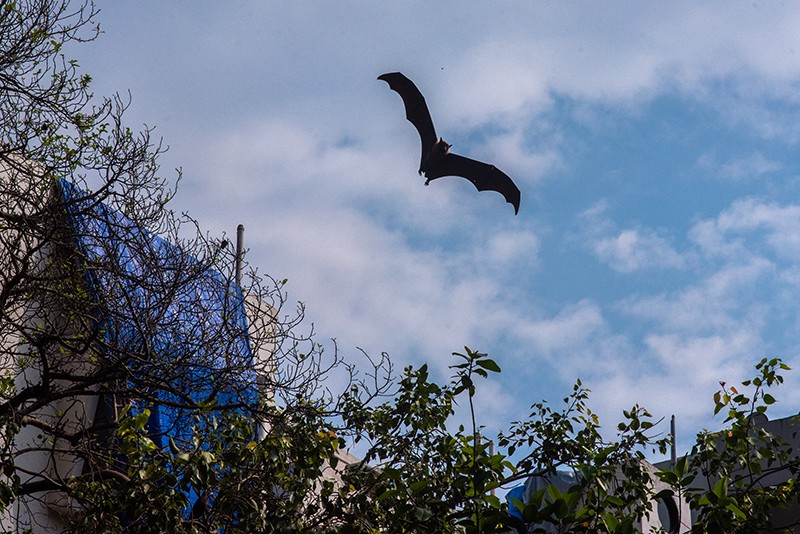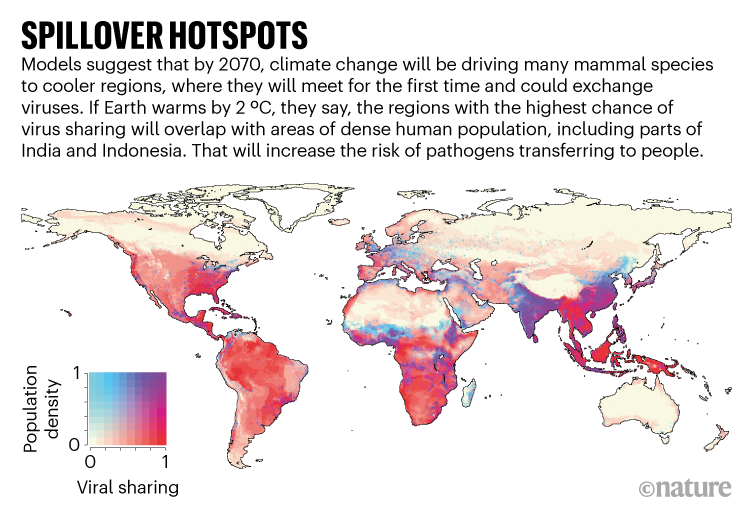

Bats will have a huge contribution to virus transmission between species in the future, a modelling examine finds.credit score: Pratik Chorge/Hindustan instances by means of Getty
Over the next 50 years, local weather change may power more than 15,000 new instances of mammals transmitting viruses to other mammals, in keeping with a examine published in Nature1. It's probably the most first to predict how international warming will shift natural world habitats and raise encounters between species capable of swapping pathogens, and to quantify how repeatedly viruses are expected to bounce between species.
Many researchers say that the COVID-19 pandemic probably all started when a in the past unknown coronavirus passed from a wild animal to a human: a process known as zoonotic transmission. A anticipated upward push in viruses jumping between species could set off greater outbreaks, posing a serious hazard to human and animal fitness alike, the examine warns — presenting all the extra cause of governments and health groups to invest in pathogen surveillance and to enrich health-care infrastructure.
The look at is "a crucial first step in knowing the future chance of local weather and land-use alternate on the subsequent pandemic", says Kate Jones, who models interactions between ecosystems and human health at university school London.
The research predicts that a great deal of the brand new virus transmission will turn up when species meet for the first time as they move to cooler locales as a result of rising temperatures. And it projects that this could ensue most commonly in species-wealthy ecosystems at excessive elevations, principally areas of Africa and Asia, and in areas that are densely populated by means of people, including Africa's Sahel place, India and Indonesia. Assuming that the planet warms with the aid of no more than 2 °C above pre-industrial temperatures this century — a future expected through some climate analyses — the number of first-time conferences between species will double with the aid of 2070, developing virus-transmission hotspots, the analyze says.
"This work provides us with greater incontrovertible facts that the arriving decades will no longer handiest be hotter, however sicker," says Gregory Albery, a sickness ecologist at Georgetown university in Washington DC and a co-creator of the analyze.
The challenges of modellingTo make their predictions, Albery and his colleagues developed and tested fashions, and ran simulations over a 5-year period. They combined models of virus transmission and species distribution below a variety of local weather-alternate situations, specializing in mammals on account of their relevance to human health.


source: Ref. 1
The group built the species-distribution mannequin to predict the place mammals would flow to locate greater habitable habitats as the planet warms. The virus-transmission model predicts the likelihood of a deadly disease jumping between species for the first time, with the aid of contemplating the place species might meet as their habitats shift and how carefully connected they are evolutionarily (viruses are surely to transmit between linked species).
The modelling looks "technically impeccable", says Ignacio Morales-Castilla, a worldwide-exchange ecologist on the college of Alcalá, Spain, however he points out that forecasting workout routines reminiscent of this every now and then should encompass unrealistic assumptions. however he adds that the breadth and scope of the analysis and its potential to determine which elements of the world might possibly be most in danger "clearly stand out".
One assumption the researchers had to make changed into about how in every single place species would unfold as the climate changes. however factors similar to even if mammals can adapt to native situations or bodily pass obstacles in landscapes are intricate to predict.
Bats are projected to be worried in viral transmission even with these elements, the study found. thought to be a part of the origins of COVID-19, bats are frequent reservoirs of viruses and make up about 20% of mammals. The team says that — partially as a result of bats can fly — they are much less likely to experience boundaries to shifting their habitats.
Spillovers to people?despite the fact Jones applauds the look at, she urges caution when discussing its implications for human health. "Predicting the risk of viral jumps from mammals into humans is greater complicated, as these spillovers take vicinity in a posh ecological and human socio-economic ambiance," she says.
Many components may reduce the chance to human fitness, together with multiplied investment in fitness care or an epidemic being unable to contaminate people for some intent, she provides.
but the researchers urge that there isn't any time to waste. Earth has already warmed by greater than 1 °C above pre-industrial temperatures, and here's riding species migration and disorder swapping. "It's happening and it's not preventable, even within the premier local weather-trade scenarios," Albery says.
Albery and one of his co-authors, Colin Carlson, a global-alternate biologist additionally at Georgetown institution, say that although some boost in sickness transmission is inevitable, that isn't any excuse for inactiveness. The researchers name on governments and the foreign community to improve the monitoring and surveillance of wild animals and zoonotic diseases, specifically in future hotspots such as southeast Asia. improving health infrastructure is also basic, they say.
As people begin to prepare for and adapt to international warming, most efforts center of attention on actions akin to halting deforestation or reinforcing sea partitions. however Carlson says pandemic preparedness and disease surveillance are local weather-alternate adaptation, too.

Post a Comment